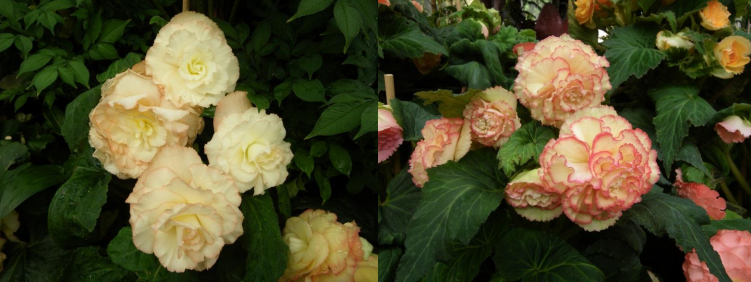TUBEROUS BEGONIAS

Large-flowered tuberous begonias come with many flower types, both upright and pendulous, single or double-flowered, and with frilled or plain petals. Tuberous begonias offer a wide colour choice of white, pink, rose, red, orange, and yellow. Flower heads consist of one large male flower in the centre and two smaller female flowers at the sides. Some flowers can be very large. The smaller female flowers can detract from the more spectacular male flower and, unless seed is to be collected, the female flowers are best removed. Male flowers are double and females have a single row of petals.
Most common flower forms are the Rose form or camellia flowered begonia. The large double flowers have rounded petals and a rosebud- like centre with a more formal appearance than other types. Ruffled tuberous begonias are a recent development and these have serrated, scalloped or heavily-waved petals. Some of these resemble large carnations and the best of these also have a rosebud centre. The term ‘picotee’ is not only a descriptive term for begonia flowers and applies to many other plants. It describes a contrast in flower colour between the main petal colour and the edges of each. Picotees usually have a petal base colour of white, cream, lemon, yellow or soft pink, whereas the edges of the petals are a stronger, contrasting colour. The effect is spectacular.
To grow tuberous begonias well, there are three things to remember. You’ll need the right position, a good quality potting mix and good watering practices.
Tuberous begonias prefer cool nights, so growing them indoors is not an option, but a fernery, conservatory or porch can be ideal. Choose a good quality open potting mix, adding 10% Perlite and some slow release fertiliser. Once actively growing, begonias thrive on liquid organic fertilizer, such as seaweed extract or fish emulsion. Potting up should commence in September with freshly bought tubers or existing tubers which you will have overwintered in a shallow tray of potting mix in a dry dark area. Dividing tubers when they are dormant is not recommended as cut surfaces will rot. Place the tubers into the recommended soil mix in small bloomer-size pots to start their growth cycle and place them somewhere where they will be free of frosts. When the tubers commence growing, tiny cracks will appear in the soil mix, usually around August or September. At this time watering becomes important. Pots should be kept evenly moist with a light application of water but only when the surface of the potting mix begins to dry out.
Seed propagation can also be done in spring. The seed is very fine, like dust, and should be sprinkled on the surface of a fine textured seed raising mix and left uncovered. It should be kept moist. Over watering is the most common cause of poor results or loss of tubers. Watering should match the stage in the growth cycle of tuberous begonias. The active growth stage is usually from October until May. Pots should be near-dry between watering and so growing in baskets can be a useful way to grow your begonias, but if the surface of the potting mix dries out completely, then thoroughly water the pot.
When new leaves appear, you can make stem cuttings When a tuber sprouts more than one stem, keep only one and use the others as cuttings. Wait until the additional stem/s reach about 7-10cm in height and snap firmly near its/their base and close to the tuber. Each cutting will strike readily, but do not allow these new plants to flower in the first year of growth. The following year, you will have a sizeable plant with good flowers.
Once growth fills the pot, your begonias can be transferred to larger pots or baskets, where they should be kept moist in a shady area. Tall growers are best staked to avoid damage. Shade cloth or slat-covered areas are ideal.
Disbud your tuberous begonias in February, leaving only the centre male flower on each flowering stem. Moisten but don’t overwater. In April, reduce watering and move your plants to a frost-free area to allow them to die down for winter. Once the stems fall off in May, the tubers can be removed from their pots and over-wintered in a shallow tray of potting mix, covered with a plastic bag and placed in a dry dark area.
From about early June to August cease watering completely. Potted tubers can be stored in their pots in a dry dark place or removed from the pots and stored in a shallow tray of potting mix in a dry, dark place.
Problems: The most common problem is rotting due to fungal or bacterial infection. Avoid over-watering and keep the tubers dry during dormancy. It is vital to allow the potting mix surface to dry out between waterings during the active growth stage.
Caterpillars may be a nuisance, but if you are vigilant, you can find them and squash them before they do too any real damage to your plants.
Powdery mildew looks like spotted talcum power on the leaves. Use either an appropriate fungicide or 1 teaspoon soda bicarbonate in a litre spray of water. The bi-carb spray will need to be reapplied each week, and after rain.






